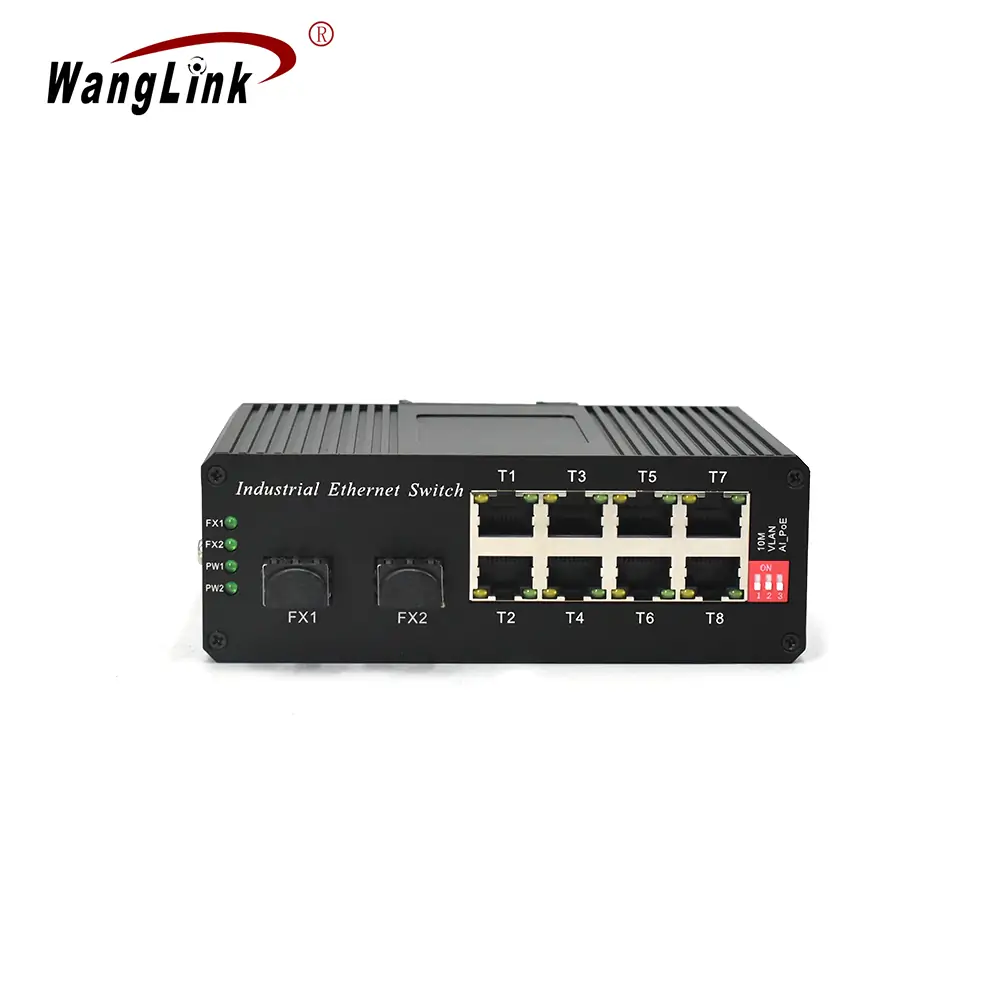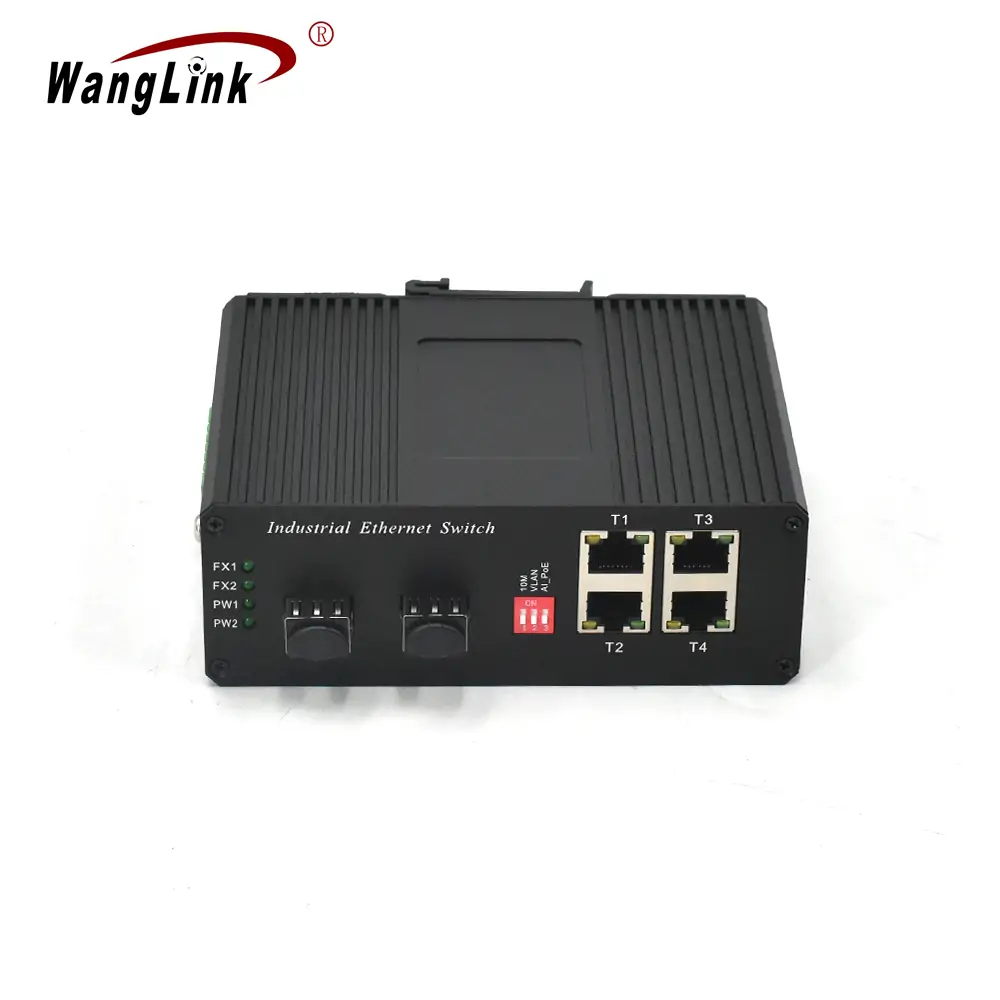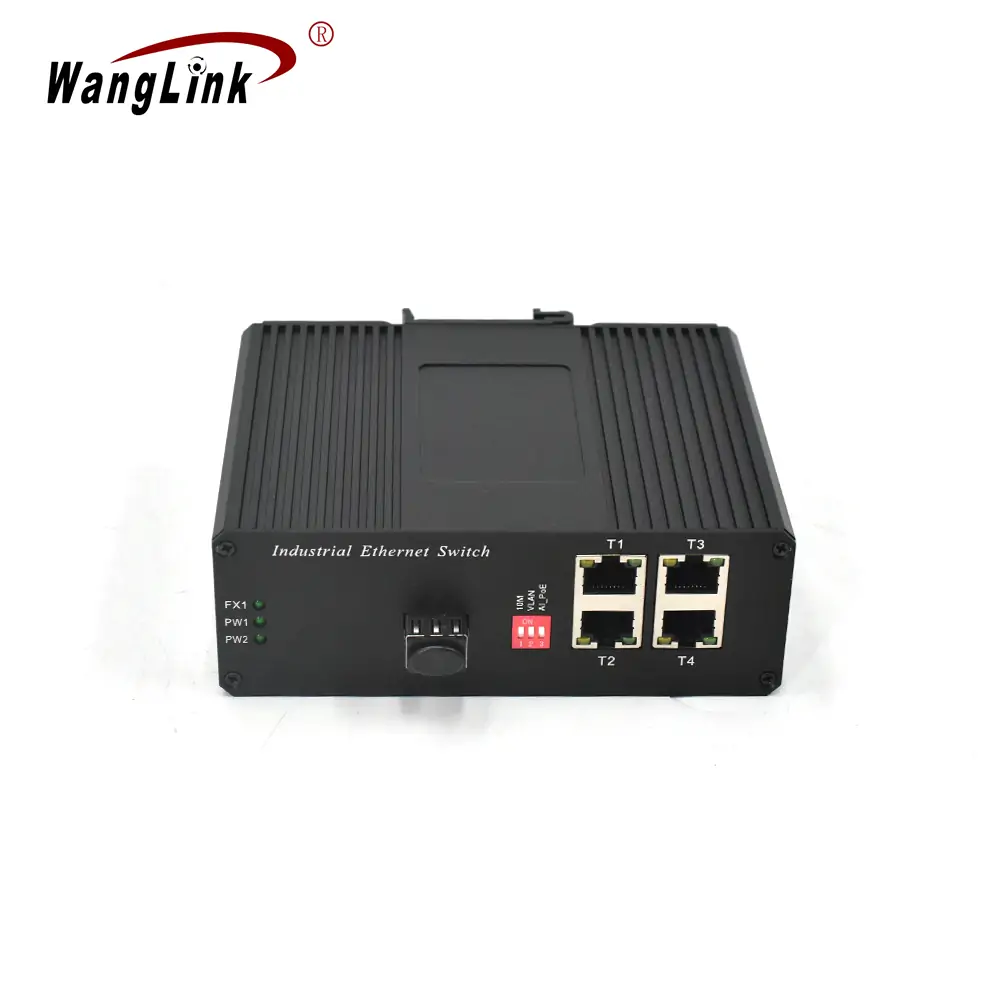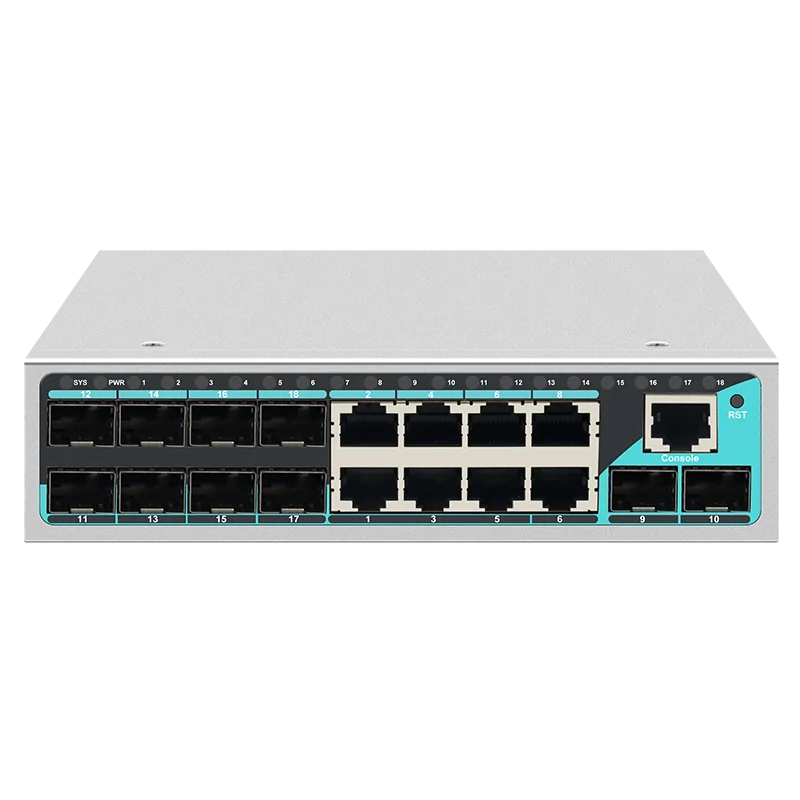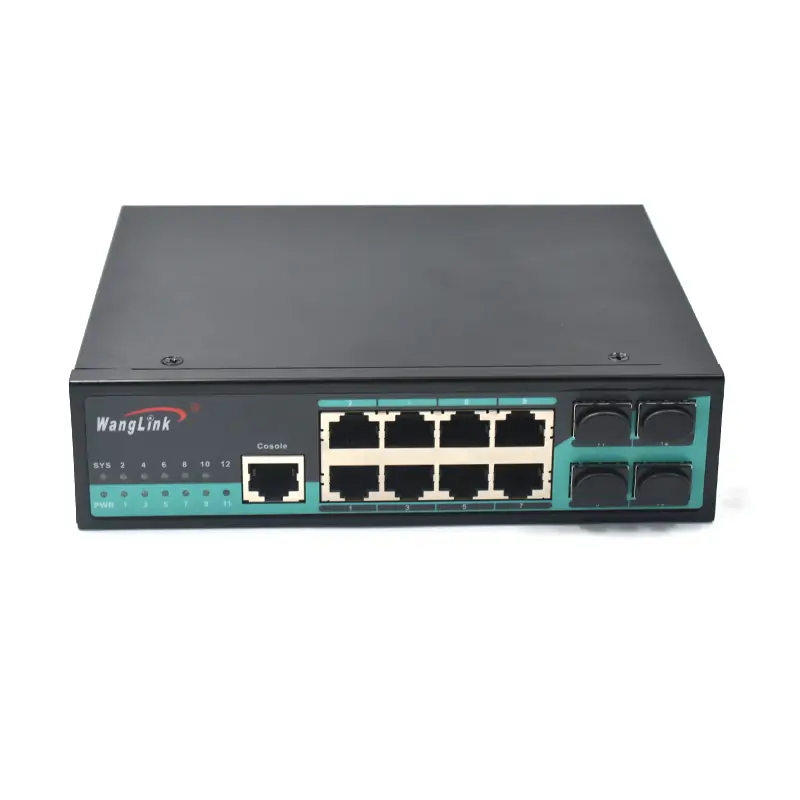Ethernet Switch Box with USB Power: Complete Guide to USB-Powered Network Solutions
In today’s interconnected world, network infrastructure demands flexibility, portability, and efficiency. The ethernet switch box with usb power represents a revolutionary approach to network expansion, combining compact design with convenient USB power delivery. As a leading ethernet switch manufacturer, Wanglink has witnessed the growing demand for these versatile networking solutions across various industries.
A sleek, modern ethernet switch box in a 16:9 aspect ratio photograph. The device features a matte black aluminum housing with 5 ethernet ports on the front panel and a USB-C power input on the side. The switch sits on a clean white desk surface with soft, professional lighting creating subtle shadows. LED indicators glow blue on each active port. The background shows a blurred modern office environment with warm, natural lighting from a window.Understanding USB-Powered Ethernet Switches
What is an Ethernet Switch Box with USB Power?
An ethernet switch box with USB power is a compact networking device that expands network connectivity while drawing power directly from USB sources. Unlike traditional switches requiring dedicated power adapters, these devices leverage USB power delivery standards to operate efficiently with minimal power consumption.
Key Advantages of USB Power Integration
USB-powered ethernet switches offer several compelling benefits:
- Portability: Eliminates bulky power adapters for mobile networking
- Simplified Setup: Single USB connection for both power and management
- Energy Efficiency: Optimized power consumption reduces operational costs
- Desk Space Optimization: Compact form factor minimizes workspace clutter
- Universal Compatibility: Works with various USB power sources
Technical Specifications and Features
Power Requirements and USB Standards
Modern USB-powered ethernet switches support multiple power delivery standards:
| USB Standard | Power Output | Typical Port Count | Application |
|---|---|---|---|
| USB 2.0 | 2.5W | 2-3 ports | Basic connectivity |
| USB 3.0 | 4.5W | 3-4 ports | Standard office use |
| USB-C PD | 15-100W | 5-8 ports | High-performance applications |
| USB-C PD 3.0 | Up to 240W | 8+ ports | Enterprise solutions |
Performance Characteristics
High-quality USB-powered switches deliver enterprise-grade performance despite their compact size:
- Data Transfer Rates: Gigabit ethernet support (1000 Mbps)
- Switching Capacity: Non-blocking architecture for full-duplex communication
- Latency: Sub-microsecond switching delays
- MAC Address Table: 8K+ address learning capacity

Applications and Use Cases
Small Office and Home Office (SOHO)
USB-powered ethernet switches excel in SOHO environments where:
- Desk Space is Limited: Compact design fits seamlessly into workspace
- Power Outlets are Scarce: USB power eliminates adapter requirements
- Temporary Setups: Easy deployment for project-based work
- Cost Sensitivity: Lower total cost of ownership
Mobile and Temporary Installations
These switches prove invaluable for:
- Trade Shows and Exhibitions: Quick network setup without infrastructure
- Field Operations: Portable networking for remote locations
- Educational Environments: Classroom network expansion
- Event Management: Temporary connectivity solutions
Case Study: Digital Marketing Agency Implementation
TechFlow Marketing, a growing digital agency, faced networking challenges in their open-plan office. With limited power outlets and frequent desk reconfigurations, traditional switches proved cumbersome.
Challenge:
- 25 workstations requiring network connectivity
- Frequent office layout changes
- Limited power infrastructure
- Budget constraints for network upgrades
Solution:
TechFlow implemented Wanglink’s USB-powered 5-port ethernet switches across their workspace. Each switch connected to workstation USB ports, providing additional network ports for devices.
Results:
- 40% reduction in cable management complexity
- Eliminated need for 15 power adapters
- Saved $2,400 in electrical infrastructure upgrades
- Improved workspace flexibility by 60%
Selection Criteria and Considerations
Port Count and Density
Choosing the appropriate port count depends on specific requirements:
2-4 Port Switches:
- Individual workstation expansion
- Home office applications
- Basic connectivity needs
5-8 Port Switches:
- Small team environments
- Conference room setups
- Moderate expansion requirements
8+ Port Switches:
- Department-level networking
- High-density applications
- Enterprise edge deployment
Power Budget Analysis
Understanding power requirements ensures optimal performance:
| Device Type | Power Consumption | USB Requirement | Efficiency |
|---|---|---|---|
| Unmanaged 4-port | 3.5W | USB 3.0 | 85% |
| Managed 5-port | 6.2W | USB-C PD | 88% |
| Industrial 8-port | 12.8W | USB-C PD 2.0 | 90% |
| Enterprise 16-port | 28.5W | USB-C PD 3.0 | 92% |
Build Quality and Reliability
Professional-grade USB ethernet switches feature:
- Aluminum Housing: Superior heat dissipation and durability
- Fanless Design: Silent operation for office environments
- ESD Protection: Robust protection against electrical interference
- Temperature Range: Extended operating conditions (-10°C to 70°C)
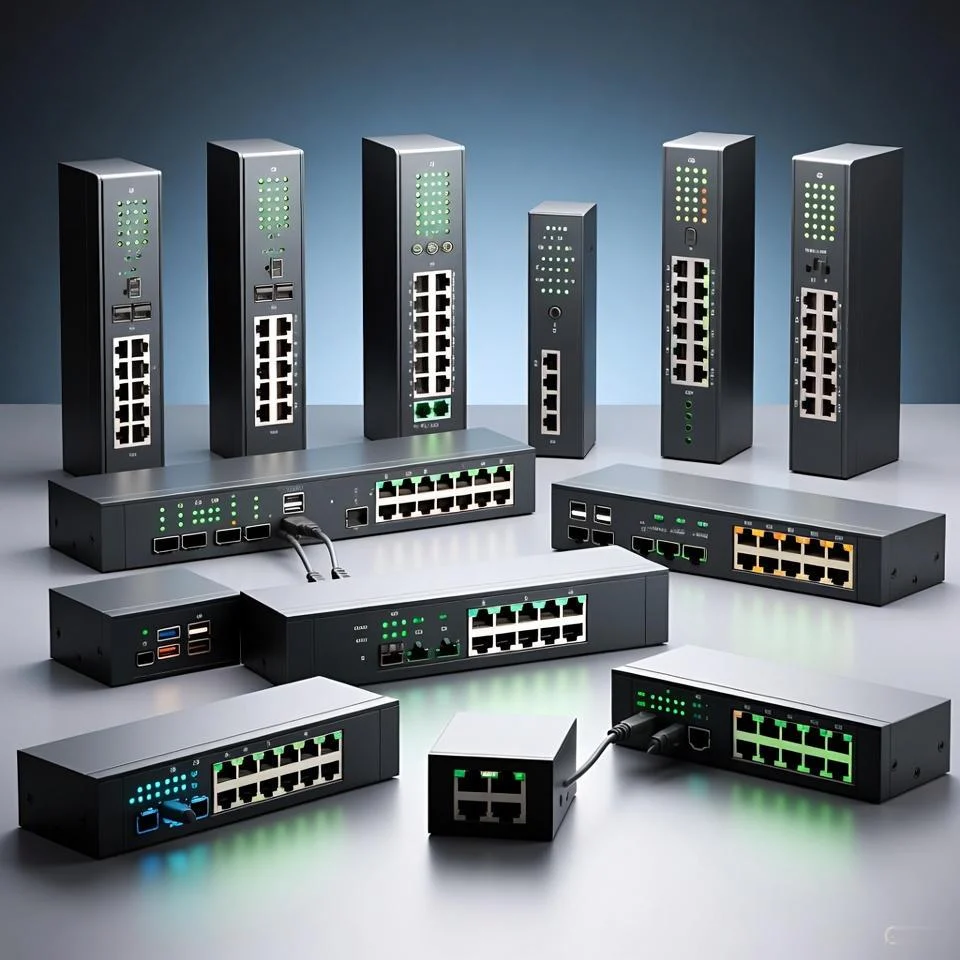
Installation and Configuration
Physical Setup Process
- Site Assessment
- Evaluate power source availability
- Determine optimal placement locations
- Plan cable routing paths
- Device Preparation
- Verify USB power compatibility
- Check ethernet cable requirements
- Prepare mounting hardware if needed
- Connection Sequence
- Connect USB power cable first
- Attach ethernet cables to devices
- Verify LED status indicators
Network Configuration
Most USB-powered switches operate as plug-and-play devices:
- Auto-negotiation: Automatic speed and duplex detection
- MAC Learning: Dynamic address table population
- Flow Control: Prevents packet loss during congestion
- Loop Prevention: Basic spanning tree support
Troubleshooting Common Issues
Power-Related Problems:
- Insufficient USB power output
- Cable quality affecting power delivery
- Multiple device power competition
Connectivity Issues:
- Cable compatibility problems
- Port configuration conflicts
- Network loop formation
Advanced Features and Management
Smart Switch Capabilities
Modern USB-powered switches offer enhanced functionality:
- VLAN Support: Network segmentation capabilities
- QoS Management: Traffic prioritization features
- Port Mirroring: Network monitoring and analysis
- SNMP Support: Remote management integration
Security Features
Enterprise-grade models include:
- Access Control Lists: Port-based security policies
- 802.1X Authentication: User-based network access
- Port Security: MAC address filtering
- Storm Control: Broadcast traffic management
Market Trends and Future Developments
Industry Evolution
The USB-powered ethernet switch market continues evolving:
- Power Efficiency Improvements: Next-generation power management
- Higher Port Densities: Increased connectivity in compact form factors
- Enhanced Management: Cloud-based configuration and monitoring
- IoT Integration: Specialized features for IoT device connectivity
Emerging Technologies
Future developments include:
- USB4 Integration: Higher power delivery capabilities
- AI-Powered Management: Intelligent traffic optimization
- Edge Computing Support: Integrated processing capabilities
- Wireless Hybrid Solutions: Combined wired/wireless functionality
Wanglink’s USB-Powered Switch Solutions
As a professional ethernet switch manufacturer with over 13 years of experience, Wanglink offers comprehensive USB-powered networking solutions. Our customization services enable tailored solutions for specific industry requirements.
Product Portfolio
Wanglink’s USB-powered switch lineup includes:
- Compact 4-Port Models: Ideal for individual workstations
- Mid-Range 8-Port Solutions: Perfect for small teams
- High-Density 16-Port Systems: Enterprise-grade performance
- Industrial-Grade Options: Ruggedized for harsh environments
Quality Assurance
Our manufacturing process ensures:
- Rigorous Testing: Comprehensive quality control procedures
- Certification Compliance: FCC, CE, and RoHS standards
- Reliability Testing: Extended burn-in and stress testing
- Performance Validation: Real-world application testing
Cost-Benefit Analysis
Total Cost of Ownership
USB-powered ethernet switches offer significant cost advantages:
Initial Investment:
- Lower hardware costs compared to PoE switches
- Eliminated power adapter expenses
- Reduced installation complexity
Operational Savings:
- Lower power consumption
- Simplified maintenance requirements
- Reduced cable management costs
Long-term Benefits:
- Enhanced workspace flexibility
- Future-proof USB power standards
- Scalable deployment options
ROI Calculation Example
For a 50-workstation office deployment:
| Cost Factor | Traditional Switch | USB-Powered Switch | Savings |
|---|---|---|---|
| Hardware | $2,500 | $1,800 | $700 |
| Power Adapters | $750 | $0 | $750 |
| Installation | $1,200 | $600 | $600 |
| Annual Power | $180 | $120 | $60/year |
| Total 3-Year | $4,810 | $2,580 | $2,230 |
Frequently Asked Questions
General Questions
Q: Can USB-powered ethernet switches handle gigabit speeds?
A: Yes, modern USB-powered switches support full gigabit ethernet speeds (1000 Mbps) on all ports when adequate USB power is available.
Q: What happens if USB power is insufficient?
A: Most switches include power management features that gracefully reduce port count or switch to lower power modes to maintain operation.
Q: Are USB-powered switches suitable for enterprise use?
A: Absolutely. Enterprise-grade models offer advanced management features, security capabilities, and reliability standards suitable for business environments.
Technical Questions
Q: Can I daisy-chain multiple USB-powered switches?
A: Yes, but consider total power requirements and network topology. Each switch needs adequate USB power, and proper network design prevents loops.
Q: Do these switches support PoE output?
A: Standard USB-powered switches don’t provide PoE output due to power limitations. However, specialized models with higher USB-C PD input can support limited PoE functionality.
Q: What’s the maximum cable length for ethernet connections?
A: Standard ethernet cable length limits apply (100 meters for Cat5e/Cat6), regardless of the switch’s power source.
Compatibility Questions
Q: Will these switches work with older USB 2.0 ports?
A: Basic models designed for USB 2.0 will work, but with limited port count and features. USB 3.0 or higher is recommended for optimal performance.
Q: Can I use a USB hub to power multiple switches?
A: This depends on the hub’s power capacity and individual switch requirements. Powered USB hubs with adequate wattage can support multiple switches.
Conclusion
Ethernet switch boxes with USB power represent a significant advancement in networking technology, offering unprecedented flexibility and convenience for modern connectivity needs. As network requirements continue evolving, these compact, efficient solutions provide the perfect balance of performance, portability, and cost-effectiveness.
Whether you’re setting up a small office, managing a temporary installation, or seeking to optimize your existing network infrastructure, USB-powered ethernet switches deliver reliable, professional-grade networking capabilities without the complexity of traditional power requirements.
For organizations seeking customized networking solutions, Wanglink’s expertise in ethernet switch manufacturing and comprehensive OEM/ODM services ensure optimal solutions tailored to specific requirements. Contact our team at [email protected] or WhatsApp +8613544167258 to discuss your USB-powered networking needs.
Visit our products page to explore our complete range of networking solutions, or check our news and knowledge base for the latest industry insights and technical guidance.

